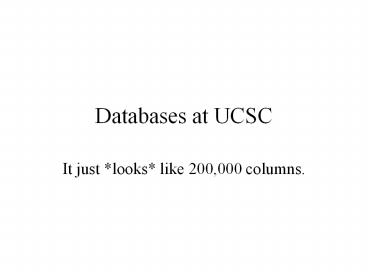Databases at UCSC PowerPoint PPT Presentation
Title: Databases at UCSC
1
Databases at UCSC
- It just looks like 200,000 columns.
2
The Databases
- Genome databases - one for each assembly of each
organism hg16, mm4, sacCer1, etc. - hgFixed - mostly microarray data.
- uniProt - Relationalized uniProt/swissProt
database. - go - Gene ontology terms and term/gene
associations. - Protein databases - Shared across organisms.
Each genome database associated with a particular
protein database. - hgCentral - home to dbDb and user settings info.
One database shared by all web servers.
3
Genome Databases
- Track data
- Parsed out GenBank data
- Data associated with knownGenes
- Proteome Browser data.
- trackDb - a table about tracks
4
Track Table Data
- Most tracks are independent of each other.
- Most tracks are in one of several formats
- genePred - stored gene structures
- alignment formats (psl, chain, net, axt, maf)
- bed, a flexible format used for simpler stuff.
- Initial field of a bed are defined, later fields
can be anything - Older and larger tracks may be split across
chromosomes. - In addition to primary table, tracks may use
other tables - typically joining via the name
or qName field of the primary table.
5
GenBank mRNA Data
- Most of the information in a GenBank flat file
record ends up in the genome database. - The mrna table contains an entry for every mRNA,
EST, and RefSeq. - The mrna table itself just contains the GenBank
accession, and ids that link into other tables. - Select mrna.acc, tissue.name from mrna,tissue
where mrna.tissue tissue.id
6
Known Genes Data
- KnownGene, and to a lesser extent RefGene link to
a lot of other tables. - The knownToXxx tables are used as the basis of
many Family Browser columns. kgXref has much of
the same data in one place. - knownCanonical/knownIsoforms group together
splicing varients. - Various BlastTab tables link known genes to
homologs in other species. - sangerGene (worm), bdgpGene (fly), sgdGene(yeast)
play similar role to knownGene in model
organisms.
7
TrackDb
- Every genome database has a trackDb table.
- trackDb contains a row for each track. Fields
include - tableName - primary table
- short long labels - seen in user interface
- type - track type
- visibility - default hide/dense/pack/full state
- Build from src/hg/makeDb/trackDb .ra files
- README in that directory describes format.
- Each developer has a trackDb_user table that
controls hgwdev-user.cse.ucsc.edu.
8
hgFixed - expression data
- Each set of expression data is associated with
two types of tables - A table ending with Exps that has information
about all the mRNA samples (tissues etc) - A table not ending in Exps that has the level of
mRNA observed for each Gene. - In some cases there may be separate tables with
log-2 based ratios as well as absolute expression
values. - In some cases there may be separate tables with
median values for replicated experiments.
9
swissProt vs. SwissProt
- SwissProt is a beautiful database, but it is
represented at Geneva as a bunch of managed
files, and externally in a flat-file format. - uniProt is an efficient relationalized version.
Best to link into this with the accession, but
can also use displayId. - See spdb.h for C library modules to access.
- Contains a wealth of protein info, and also some
good functional info in nicely structured
comments. Good xrefs to other databases. - Programmers at SwissProt have unofficially
double-checked the relationalization, Fan and I
have maintained it for several years.
10
GO Database
- This is imported directly form geneontology.org.
- Use goaPart table to find which GO terms are
associated with a SwissProt accession - Highly relational. Use term and term_definition
to find meaning of terms.
11
hgCentral
- has dbDb - a table with a row for each genome
database. This includes organism name, DNA
location, etc. - sessionDb - user cart setting for current
session - userDb - cart settings saved between sessions
- gdbPdb - relates genome and protein databases.
12
Database Documentation
- find src/hg -name \.as -print
- src/hg/makeDb/doc/.txt
- src/hg/makeDb/schema/all.joiner
- src/hg/makeDb/schema/joiner.doc
- src/hg/makeDb//.c
13
.as Files - table and field docs
table cpgIsland "Describes the CpG Islands" (
string chrom "Human chromosome or FPC
contig" uint chromStart "Start position
in chromosome" uint chromEnd "End
position in chromosome" string name
"CpG Island" uint length "Island
Length" uint cpgNum "Number of CpGs
in island" uint gcNum "Number of C
and G in island" float perCpg
"Percentage of island that is CpG" float
perGc "Percentage of island that is C or
G" )
autoSql generates code from these. They also
help document.
14
Other Docs
- Description button in table browser will fetch
relevant .as file most of the time. - makeHg18.doc and other database build docs -
describes how database was built. - all.joiner file - describes how tables are linked
together.

